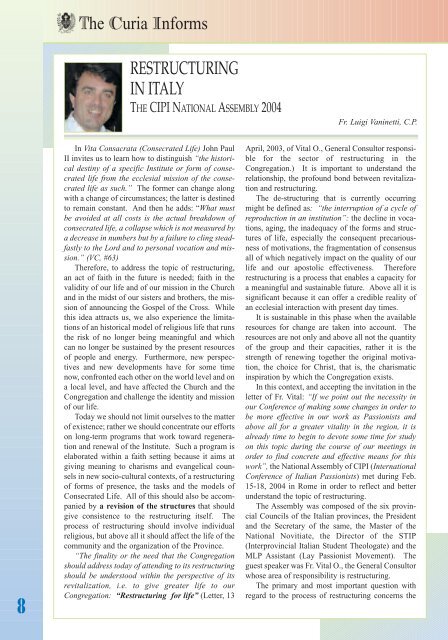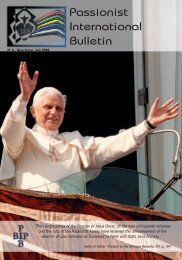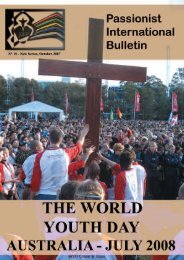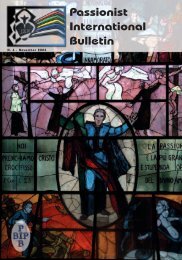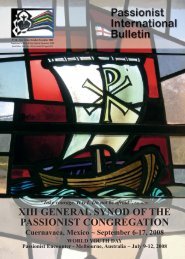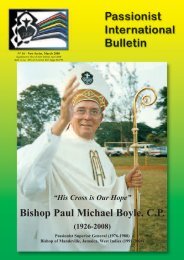Passionist International Bulletin
Passionist International Bulletin
Passionist International Bulletin
Create successful ePaper yourself
Turn your PDF publications into a flip-book with our unique Google optimized e-Paper software.
8<br />
The Curia Informs<br />
RESTRUCTURING<br />
IN ITALY<br />
THE CIPI NATIONAL ASSEMBLY 2004<br />
In Vita Consacrata (Consecrated Life) John Paul<br />
II invites us to learn how to distinguish “the historical<br />
destiny of a specific Institute or form of consecrated<br />
life from the ecclesial mission of the consecrated<br />
life as such.” The former can change along<br />
with a change of circumstances; the latter is destined<br />
to remain constant. And then he adds: “What must<br />
be avoided at all costs is the actual breakdown of<br />
consecrated life, a collapse which is not measured by<br />
a decrease in numbers but by a failure to cling steadfastly<br />
to the Lord and to personal vocation and mission.”<br />
(VC, #63)<br />
Therefore, to address the topic of restructuring,<br />
an act of faith in the future is needed; faith in the<br />
validity of our life and of our mission in the Church<br />
and in the midst of our sisters and brothers, the mission<br />
of announcing the Gospel of the Cross. While<br />
this idea attracts us, we also experience the limitations<br />
of an historical model of religious life that runs<br />
the risk of no longer being meaningful and which<br />
can no longer be sustained by the present resources<br />
of people and energy. Furthermore, new perspectives<br />
and new developments have for some time<br />
now, confronted each other on the world level and on<br />
a local level, and have affected the Church and the<br />
Congregation and challenge the identity and mission<br />
of our life.<br />
Today we should not limit ourselves to the matter<br />
of existence; rather we should concentrate our efforts<br />
on long-term programs that work toward regeneration<br />
and renewal of the Institute. Such a program is<br />
elaborated within a faith setting because it aims at<br />
giving meaning to charisms and evangelical counsels<br />
in new socio-cultural contexts, of a restructuring<br />
of forms of presence, the tasks and the models of<br />
Consecrated Life. All of this should also be accompanied<br />
by a revision of the structures that should<br />
give consistence to the restructuring itself. The<br />
process of restructuring should involve individual<br />
religious, but above all it should affect the life of the<br />
community and the organization of the Province.<br />
“The finality or the need that the Congregation<br />
should address today of attending to its restructuring<br />
should be understood within the perspective of its<br />
revitalization, i.e. to give greater life to our<br />
Congregation: “Restructuring for life” (Letter, 13<br />
Fr. Luigi Vaninetti, C.P.<br />
April, 2003, of Vital O., General Consultor responsible<br />
for the sector of restructuring in the<br />
Congregation.) It is important to understand the<br />
relationship, the profound bond between revitalization<br />
and restructuring.<br />
The de-structuring that is currently occurring<br />
might be defined as: “the interruption of a cycle of<br />
reproduction in an institution”: the decline in vocations,<br />
aging, the inadequacy of the forms and structures<br />
of life, especially the consequent precariousness<br />
of motivations, the fragmentation of consensus<br />
all of which negatively impact on the quality of our<br />
life and our apostolic effectiveness. Therefore<br />
restructuring is a process that enables a capacity for<br />
a meaningful and sustainable future. Above all it is<br />
significant because it can offer a credible reality of<br />
an ecclesial interaction with present day times.<br />
It is sustainable in this phase when the available<br />
resources for change are taken into account. The<br />
resources are not only and above all not the quantity<br />
of the group and their capacities, rather it is the<br />
strength of renewing together the original motivation,<br />
the choice for Christ, that is, the charismatic<br />
inspiration by which the Congregation exists.<br />
In this context, and accepting the invitation in the<br />
letter of Fr. Vital: “If we point out the necessity in<br />
our Conference of making some changes in order to<br />
be more effective in our work as <strong>Passionist</strong>s and<br />
above all for a greater vitality in the region, it is<br />
already time to begin to devote some time for study<br />
on this topic during the course of our meetings in<br />
order to find concrete and effective means for this<br />
work”, the National Assembly of CIPI (<strong>International</strong><br />
Conference of Italian <strong>Passionist</strong>s) met during Feb.<br />
15-18, 2004 in Rome in order to reflect and better<br />
understand the topic of restructuring.<br />
The Assembly was composed of the six provincial<br />
Councils of the Italian provinces, the President<br />
and the Secretary of the same, the Master of the<br />
National Novitiate, the Director of the STIP<br />
(Interprovincial Italian Student Theologate) and the<br />
MLP Assistant (Lay <strong>Passionist</strong> Movement). The<br />
guest speaker was Fr. Vital O., the General Consultor<br />
whose area of responsibility is restructuring.<br />
The primary and most important question with<br />
regard to the process of restructuring concerns the


